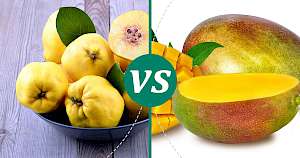Mango vs Quince Fruit: Nutrition & Calories Compare


Mango vs Quince fruit
Nutrition Facts
Serving size:
change
5g10g15g20g30g40g50g60g80g100g120g140g160g180g200g220g250g300g350g400g450g500g600g700g800g900g1000g
1oz2oz3oz4oz5oz6oz7oz8oz10oz12oz15oz20oz25oz30oz35oz40oz50oz
Amount Per Serving:
Serving size:
change
5g10g15g20g30g40g50g60g80g100g120g140g160g180g200g220g250g300g350g400g450g500g600g700g800g900g1000g
1oz2oz3oz4oz5oz6oz7oz8oz10oz12oz15oz20oz25oz30oz35oz40oz50oz
Amount Per Serving:
Mango vs Quince Fruit 100g Compare
| per 100g | Mango | Quince fruit |
|---|---|---|
| Calories | 78 | 57 |
| Carbohydrates | 17.4 g | 13.81 g |
| Fat | 0.68 g | 0.1 g |
| Dietary fiber | 1.29 g | 1.9 g |
| Protein | 0.69 g | 0.4 g |
| Calcium | 10.02 mg | 11 mg |
| Magnessium | 10.57 mg | 8 mg |
| Phosphorus | 0.563 mg | 11 mg |
| Potassium | 204.4 mg | 119 mg |
| Zink | 0.563 mg | 0.04 mg |
| Vitaminium A | 1082 µg | 40 µg |
| Vitaminium B1 (Thiamine) | 0.028 mg | 0.02 mg |
| Vitaminium B2 (riboflavin) | 0.038 mg | 0.03 mg |
| Vitaminium B3 (Niacin) | 0.669 mg | 0.2 mg |
| Vitaminium B5 | 0.16 mg | 0.081 mg |
| Vitaminium B6 | 0.108 mg | 0.04 mg |
| Vitaminium B9 (Folic acid) | 0.043 mg | 3 mg |
| Vitaminium C | 168.1 mg | 15 mg |
| Vitaminium E | 0.9 mg | 0.12 mg |
| Vitaminium K | 0.004 µg | 4.5 µg |
Discover the Nutritional Delights of Mango and Quince Fruit
When it comes to fruits, mangoes and quinces might not seem like they have much in common at first glance. Mango, with its tropical origins and sweet, juicy flavor, stands in contrast to the more temperate, subtly sweet, and slightly tart quince. However, both fruits bring a wealth of nutritional benefits and intriguing flavors to the table, making them wonderful additions to a healthy diet. Let’s dive into the fascinating world of mango and quince fruit, exploring not just their nutritional content, but also some engaging facts that make them truly unique.
The Marvelous Mango
Beloved around the globe, mangoes are not only delicious but also packed with nutrients. A single serving of mango provides approximately 70 calories, and boasts a generous 17 grams of carbohydrates and 1.8 grams of fiber, making it a great option for an energy-boosting snack. Mangoes are also low in fat, with just 0.27 grams, and contain a modest 0.5 grams of protein. Beyond these basics, mangoes are a powerhouse of vitamins and minerals. They shine particularly bright in their vitamin A content, offering 765 micrograms per serving. This fruit is also a good source of vitamin C, vitamin E, and various B vitamins, alongside essential minerals such as calcium, iron, magnesium, and potassium.
The Quintessential Quince
Quince might not be as widely recognized as mango, but it is a fruit that deserves attention for its unique flavor and nutritional profile. A serving of quince fruit contains about 57 calories, 13.81 grams of carbohydrates, and 1.9 grams of fiber, slightly edging out mango in dietary fiber. With a minuscule 0.1 grams of fat and 0.4 grams of protein, quince is another fruit that fits well into a health-conscious diet. Quince is particularly noted for its vitamin C content, providing 15 milligrams per serving. It also offers a good mix of other nutrients, including iron, potassium, and various B vitamins, making it a nutritious choice for those looking to diversify their fruit intake.
Nutritional Comparison at a Glance
- Calories: Mango leads slightly with 70 calories per serving, compared to quince's 57.
- Carbohydrates and Fiber: Mango and quince are fairly close in carbs, but quince has a slight edge in dietary fiber.
- Fat and Protein: Both fruits are low in fat and protein, fitting easily into a balanced diet.
- Vitamins and Minerals: Mango stands out for its high vitamin A content, whereas quince offers a good dose of vitamin C and iron.
Adding Mango and Quince to Your Diet
Whether you’re drawn to the tropical sweetness of mango or the distinctive taste of quince, both fruits offer a delightful way to enhance your meals while boosting your nutritional intake. Mango can be enjoyed on its own, in smoothies, salads, or as a sweet addition to salsas and desserts. Quince, on the other hand, is excellent when poached, baked, or turned into jellies and preserves, lending its aromatic flavor to a variety of dishes.
In conclusion, while mango and quince may cater to different taste preferences, they both serve as nutritious, flavorful choices for anyone looking to enrich their diet with more fruits. Whether you’re after the vitamin-packed sweetness of mango or the fiber-rich, subtly tart quince, incorporating these fruits into your meals can add a burst of flavor and a wealth of health benefits.
Mango 100g
78kcalCalories source
- 89% CARBS.
- 4% PROTEIN
- 8% FAT
Quince fruit 100g
57kcalCalories source
- 96% CARBS
- 3% PROTEIN
- 2% FAT
Compares of mango
- Mango vs Apple
- Mango vs Apricot
- Mango vs Avocado
- Mango vs Banana
- Mango vs Blackberry
- Mango vs Blackcurrants
- see all compares of mango
Marcin Piotrowicz
calories-info.com creator
Healthy diet and healthy lifestyle promoter
Add comment